I recently added the below image of a wind band from the Seville Cathedral (1564) to the Trombone History Timeline (16th century). This image brought to mind a discussion in a book I’ve been reading regarding exactly when, in the history of the trombone, players began reading from printed music. Here is the assertion: Speaking of a 1522 painting of an outdoor wind band, the author states, “Not only in this painting, but in all others that depict instrumental ensembles of the time, the players are not using music. By the 1520s, it is fairly clear that professional musicians could read music, but they did not use it in performance. Like their illiterate predecessors, they memorized hundreds of tunes and then either improvised counterpoint or worked something out in rehearsal, memorized it, and probably embellished it profusely” (Guion, A History 95; emphasis added). Based on the images below from the 16th and early 17th centuries, do you agree? Obviously, some of the depictions have the appearance of being fairly literal, while others are clearly symbolic; however, even the symbolic images have a certain amount of usefulness, as they very likely stem from contemporary norms or ideals. In fairness, I should add that some of these images have not been widely known in the trombone community.
16th century—Mexico: An anonymous painting in the church of San Esteban in Tizatlan, Tlaxcala, depicts a choir of angel musicians consisting of 3 shawms and a trombone (see below image; public domain) (Starner 110). The players all read from a single music stand. A wider view of the image can be seen here or here (see upper-right).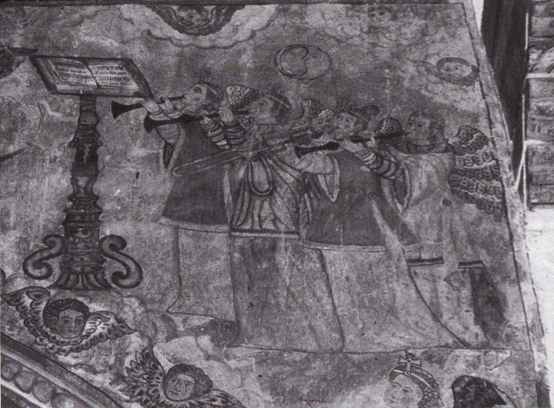 1526—In the famous series of woodcuts titled The Triumph of Maximilian, executed primarily by artist Hans Burgkmair, one image (Plates 25-26) depicts a wagon transporting the Emperor’s Hofkapelle (court band), with cornett, trombone, and a number of singers, all the performers reading from a large music desk. See below image (Burgkmair, Triumph 5-6, plate 26; public domain).
1526—In the famous series of woodcuts titled The Triumph of Maximilian, executed primarily by artist Hans Burgkmair, one image (Plates 25-26) depicts a wagon transporting the Emperor’s Hofkapelle (court band), with cornett, trombone, and a number of singers, all the performers reading from a large music desk. See below image (Burgkmair, Triumph 5-6, plate 26; public domain).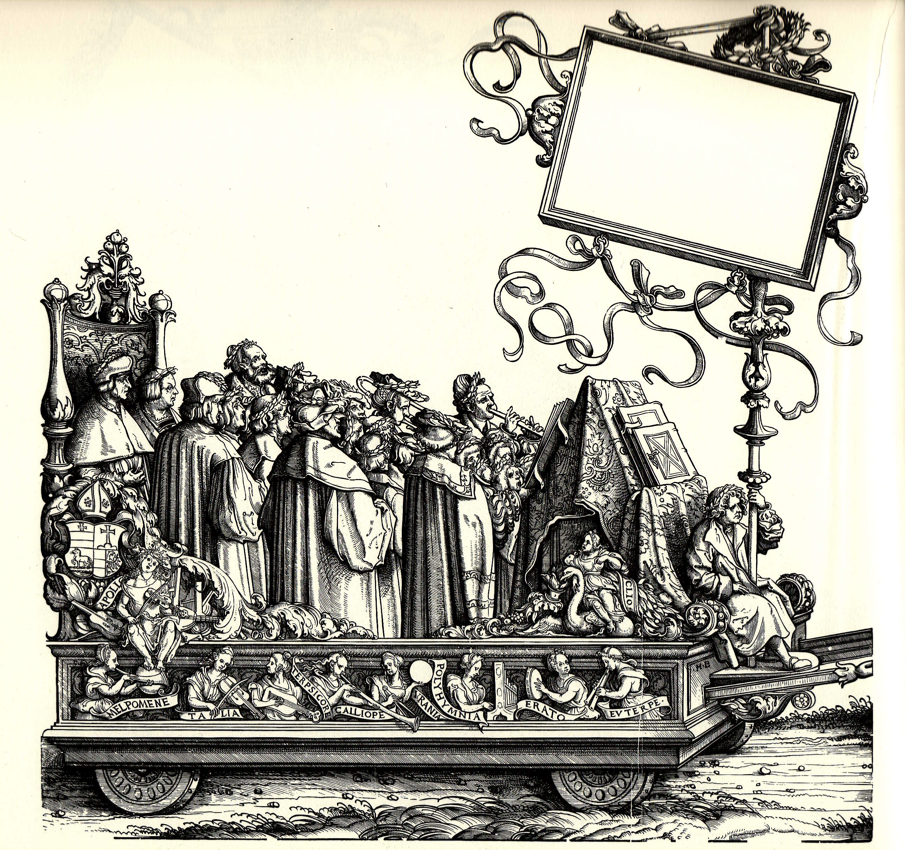 1564—Seville, Spain: At the Seville Cathedral, a bronze medallion by Juan Marin and Bautista Vazquez portrays 2 trombones performing with a cornett and 2 shawms. The 5 players are all gathered around a single music stand (see below image; public domain) (Kreitner, Minstrels in Spanish Churches).
1564—Seville, Spain: At the Seville Cathedral, a bronze medallion by Juan Marin and Bautista Vazquez portrays 2 trombones performing with a cornett and 2 shawms. The 5 players are all gathered around a single music stand (see below image; public domain) (Kreitner, Minstrels in Spanish Churches).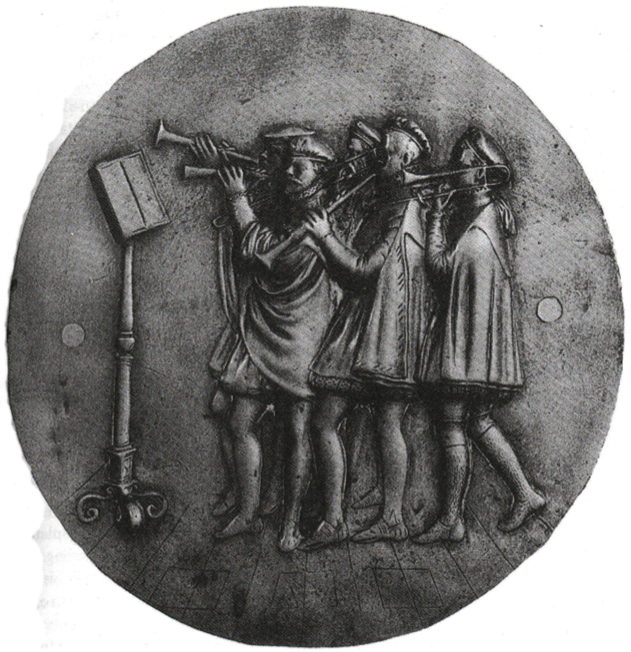 c. 1575—Pieter de Witte’s painting, David Singing God’s Praise, features trombone among a mixed consort of angel-musicians. The angel-trombonist appears to be reading from music held by another angel. The upper half of the painting (see below image) is meant to depict Saint Cécile and angels. The lower half, not shown, depicts angels performing with David (Haarlem, Frans Hals Museum, photo A. Dingjan; Pieter Fischer 22) (public domain image). Several subsequent copies of the painting on various media retain the same basic image (see 16th century timeline).
c. 1575—Pieter de Witte’s painting, David Singing God’s Praise, features trombone among a mixed consort of angel-musicians. The angel-trombonist appears to be reading from music held by another angel. The upper half of the painting (see below image) is meant to depict Saint Cécile and angels. The lower half, not shown, depicts angels performing with David (Haarlem, Frans Hals Museum, photo A. Dingjan; Pieter Fischer 22) (public domain image). Several subsequent copies of the painting on various media retain the same basic image (see 16th century timeline).
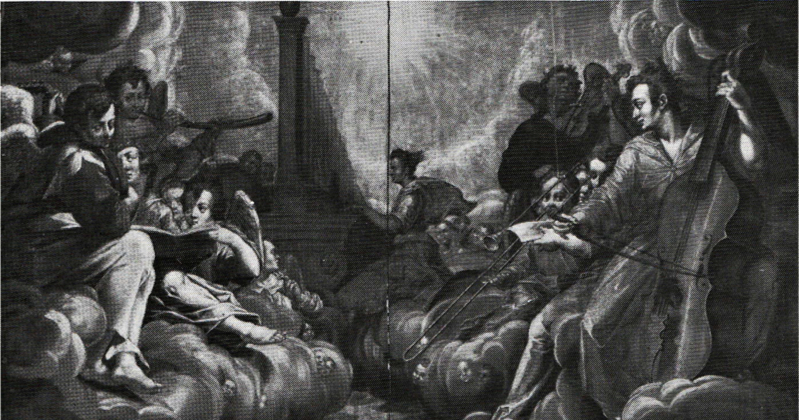 1578—Antwerp, Belgium: A set of masses by George de La Hele includes an image–an initial D in front of a group of cherub musicians–that features a rear-facing trombone being played by a cherub (also rear-facing) (see below image; public domain; Wangermée vol. 1 167). The wind players all appear to be reading from a single central music volume.
1578—Antwerp, Belgium: A set of masses by George de La Hele includes an image–an initial D in front of a group of cherub musicians–that features a rear-facing trombone being played by a cherub (also rear-facing) (see below image; public domain; Wangermée vol. 1 167). The wind players all appear to be reading from a single central music volume.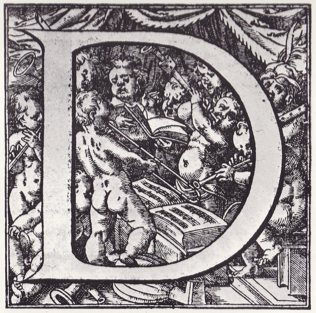 1595—Antwerp, Belgium: Philippe Galle’s copperplate engraving, after a work by Johannes Stradanus (Jan van der Straat), features trombone performing in a sacred setting, during the celebration of a Mass. One trombone is pictured in the immediate foreground, while another, possibly an alto trombone, is shown very near the music desk. The performers appear to be reading from a central music desk (see below image; public domain) (Salmen, Musikleben im 16 183; Naylor 10).
1595—Antwerp, Belgium: Philippe Galle’s copperplate engraving, after a work by Johannes Stradanus (Jan van der Straat), features trombone performing in a sacred setting, during the celebration of a Mass. One trombone is pictured in the immediate foreground, while another, possibly an alto trombone, is shown very near the music desk. The performers appear to be reading from a central music desk (see below image; public domain) (Salmen, Musikleben im 16 183; Naylor 10).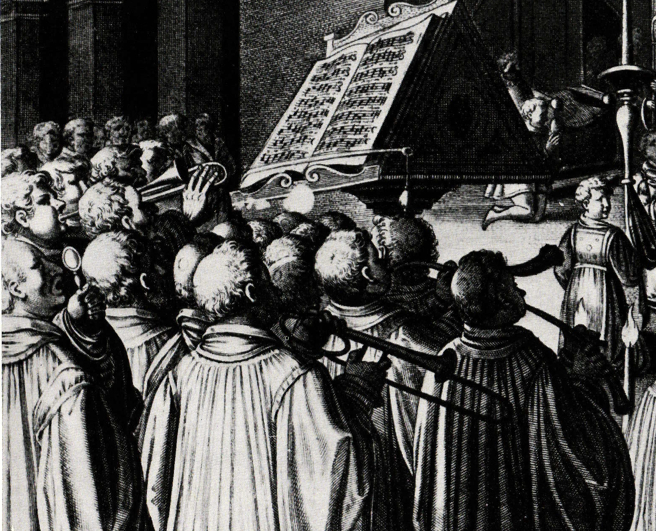 1600s—Thaleia, Muse of Comic Poetry, an anonymous engraving, depicts a trombonist reading from music held up by a cherub or putto. The caption says, “If our story is great, or if it is a comedy of life, Our story, even after it has been told does not satisfy God, It does not create the eternal well-being which pleases us; And expressed it does not include the praises of God” (see below image; public domain) (Naylor 96).
1600s—Thaleia, Muse of Comic Poetry, an anonymous engraving, depicts a trombonist reading from music held up by a cherub or putto. The caption says, “If our story is great, or if it is a comedy of life, Our story, even after it has been told does not satisfy God, It does not create the eternal well-being which pleases us; And expressed it does not include the praises of God” (see below image; public domain) (Naylor 96).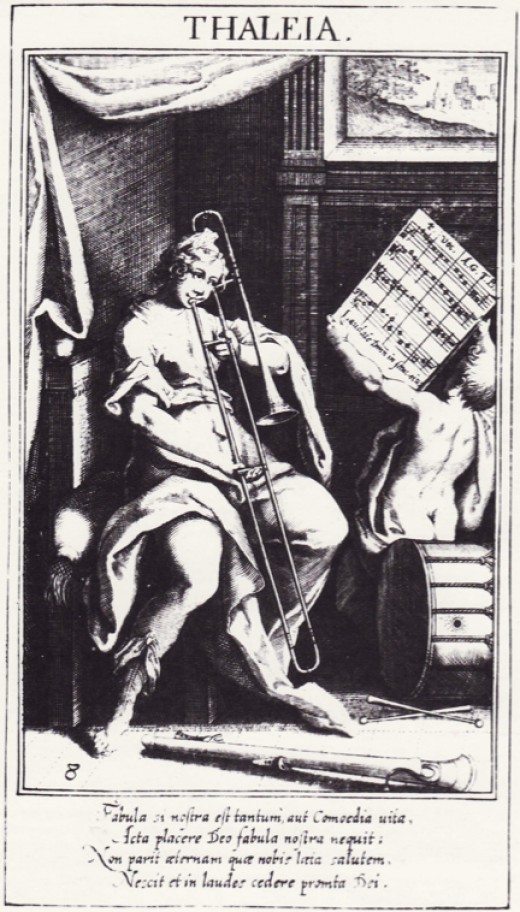 1609—Rome, Italy: Guido Reni’s Gloria d’angeli, a fresco located in S. Gregorio Magno, Cappella di S. Silvia, includes 2 trombones (see below 2 details; public domain) (Cavalli, pl. 28 and 32; Pepper, pl. 30). The musicians read from leaves of music draped over the edge of the balcony.
1609—Rome, Italy: Guido Reni’s Gloria d’angeli, a fresco located in S. Gregorio Magno, Cappella di S. Silvia, includes 2 trombones (see below 2 details; public domain) (Cavalli, pl. 28 and 32; Pepper, pl. 30). The musicians read from leaves of music draped over the edge of the balcony.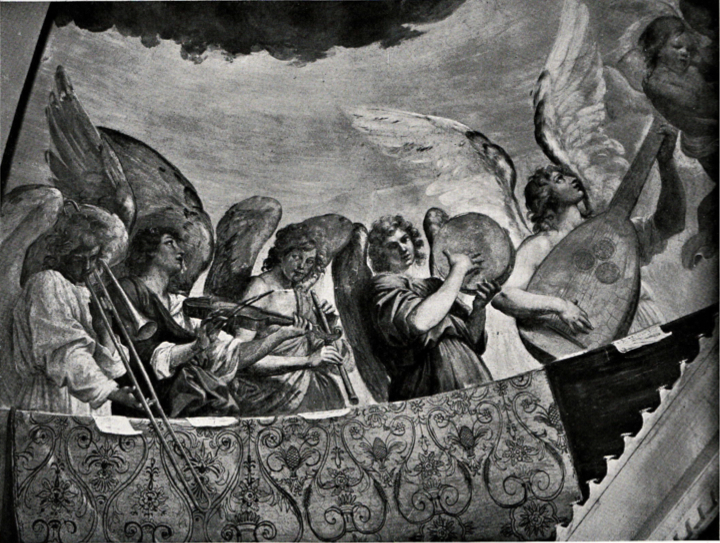
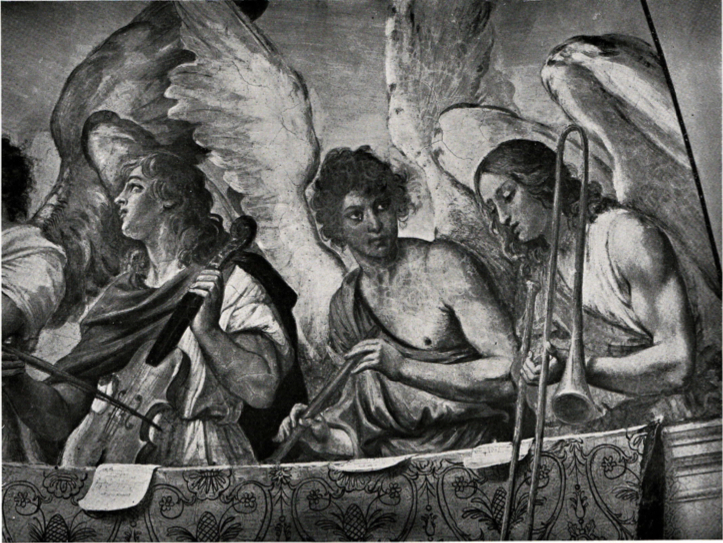 c. 1615—Cislago, Italy: The Church of Santa Maria della Neve contains an anonymous fresco lunette featuring several angel musicians, including a trombonist. The 3 wind players on the left play from music held up by a cherub or putto. The trombone is particularly noteworthy because it is a rear-facing (sometimes called “over-the-shoulder”) instrument, an unusual configuration for this early date (see below image; public domain) (Morandi; Farioli). For another early rear-facing instrument, see 1578 in the 16th century timeline, where a cherub-trombonist is featured. In later centuries, particularly the 19th century, rear-facing trombones become much more common; the 19th century timeline includes at least 9 such images.
c. 1615—Cislago, Italy: The Church of Santa Maria della Neve contains an anonymous fresco lunette featuring several angel musicians, including a trombonist. The 3 wind players on the left play from music held up by a cherub or putto. The trombone is particularly noteworthy because it is a rear-facing (sometimes called “over-the-shoulder”) instrument, an unusual configuration for this early date (see below image; public domain) (Morandi; Farioli). For another early rear-facing instrument, see 1578 in the 16th century timeline, where a cherub-trombonist is featured. In later centuries, particularly the 19th century, rear-facing trombones become much more common; the 19th century timeline includes at least 9 such images.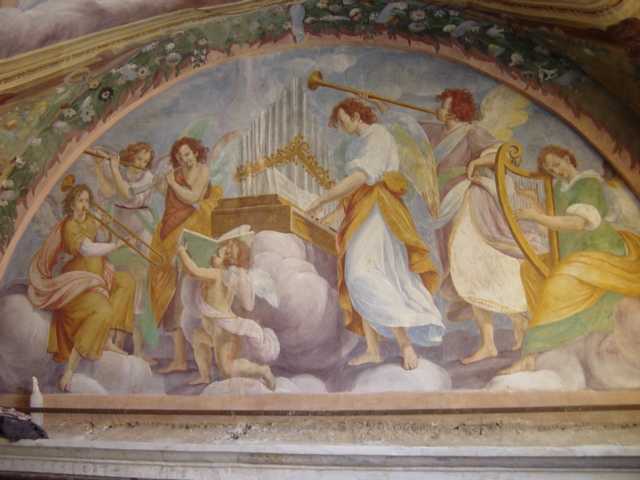 c. 1629—Venice, Italy: Veronese artist Fra Semplice da Verona includes a depiction of a cherub playing trombone in Infant Jesus and Musical Angels, an image framing a pre-existing Madonna in the Convento del Redentore. The trombonist appears to be playing from music held by one of the other cherubs. Other instruments not shown include cornetto, viol, violin, and lute (see detail below) (Portogruaro, plate 37).
c. 1629—Venice, Italy: Veronese artist Fra Semplice da Verona includes a depiction of a cherub playing trombone in Infant Jesus and Musical Angels, an image framing a pre-existing Madonna in the Convento del Redentore. The trombonist appears to be playing from music held by one of the other cherubs. Other instruments not shown include cornetto, viol, violin, and lute (see detail below) (Portogruaro, plate 37).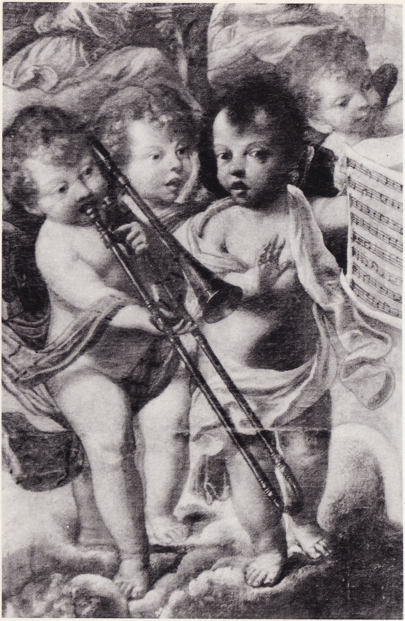
Maria
Hi,
I have a private music classroom and at the moment creating a site to give support to our kids here http://readmusic.org
Do you mind if, perhaps My partner and I quote a several of your posts as long as I include credit coupled with sources back to your blog site? Our web site is actually in the exact similar area of interest as yours and my users would most likely definitely gain from a lot of the information you provide in this article. Please let me know if this ok with you.
Thanks much!
wkimball
Maria,
Of course—feel free to quote. A link to the site would be great. Good luck with your music endeavors!
WK